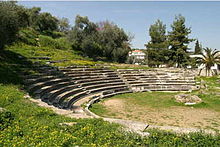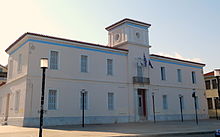Gytheio
It is the site of ancient Cranae, a tiny island where, according to the myth, Paris and Helen spent their first night together before departing for Troy.Gytheio used to be an important port until it was destroyed in 4th century AD, possibly by an earthquake, though its strategic location continued to give it a significant role in Maniot history.Directly north and visible from the harbor is Profitis Ilias, the ultra-prominent peak of Taygetus, the mountain range whose spine juts southward into the Mediterranean Sea and forms the Mani Peninsula.Approximately 5 km (3 mi) southwest is a passageway to the deeper Mani, historically guarded by Castle Passavas (now in ruins), which towers over the site of ancient Las.The reputed founders of ancient Gythium were Heracles and Apollo,[7] who frequently appear on its coins or in other legends, and Castor and Pollux:[8] the former of these names may point to the influence of Phoenician traders from Tyre, who, we know, visited the Laconian shores at a very early period.[14] The highest officer of the confederacy was the general, who was assisted by a treasurer (rauias), while the chief magistrates of the several communities bore the title of ephors.[8] What happened to Gythium is not recorded but it is thought to have been either sacked by Alaric and the Visigoths, pillaged by the Slavs or destroyed by the massive earthquake that struck the area in 375 AD.Gytheio is twinned with: ^ Roman Gythium: Pausanias has left us a description of the town as it existed in the reign of Marcus Aurelius, the agora, the Acropolis, the island of Cranae (Marathonisi) where Paris celebrated his nuptials with Helen of Troy, the Migonium or precinct of Aphrodite Migonitis (occupied by the modern town), and the hill Larysium (Koumaro) rising above it.







Municipal unitGreeceAdministrative regionPeloponneseRegional unitLaconiaMunicipalityEast ManiTime zonePostal codeArea code(s)Vehicle registrationAncient GreekMani PeninsulaAncient SpartaCranaeearthquakeManiot historythe Mani PeninsulaLaconian Gulfultra-prominentTaygetusMediterranean SeaMonastery of Panayia YiatrissaE4 hiking pathEvrotas RiverAreopoliCaves of DirosSpartiGreek National Road 39MavrovouniErnst ZillerHeraclesApolloCastor and PolluxPhoenicianPerioeciFirst Peloponnesian WarTolmideshoplitesPeloponnesian WarAlcibiadesThebansEpaminondasPhilip V of MacedonRoman-Spartan WarUnion of Free LaconiansAcheanAulus Atilius SerranusCaesar AugustusephorsporphyryAlaricVisigothsByzantineOttomanGreek War of IndependenceKythiraDioceseOityloMetropolitan bishopOrthodoxChurch of GreeceDimitrios shipwreckprovincesAlexandros OthonaiosPrime Minister of GreeceTzannis TzannetakisList of twin towns and sister cities in GreecetwinnedVilleneuve-lès-AvignonFranceGovernment GazettePausaniasPolybiusPaul CartledgePatrick Leigh FermorPeter GreenWilliam Leakepublic domainTod, Marcus NiebuhrChisholm, HughEncyclopædia BritannicaSminosKrokeesLefktroPyrrichosDrosopigiKalyviaMyrsiniSkoutariDryalosGerolimenasKelefaPyrgos DirouVatheiaKastaniaregionprefectureAtticaWest AtticaPiraeusAeginaTroiziniaMegarisCentral GreeceBoeotiaLivadeiaThebesEuboeaChalcisIstiaiaKarystiaPhocisDoridaParnassidaPhthiotisDomokosLocrisCentral MacedoniaChalkidikiArnaiaImathiaNaousaKilkisPaionia